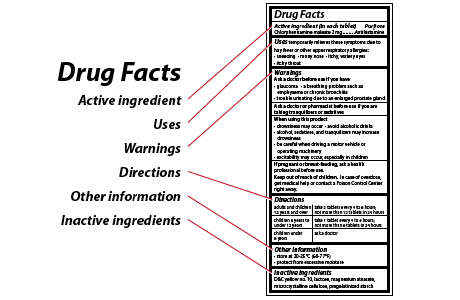Important guide on How to Read Medicine Labels.
Read the medication label before each time you take an over-the-counter (OTC) or prescription (Rx) medication. Every medication comes with specific usage guidelines that must be followed to the letter at all times. The directions explain how to take the medication, how much to take, when to take it, and when not to take it.

To ensure you have access to the correct dosage instructions, always maintain your medications in their original package. To read more, scroll over the OTC medicine label below, click on it, or go to the section below that discusses how to read prescription drug labels.
Over-the-Counter Drug Facts
Drugs that can be purchased without a prescription over-the-counter, or OTC, are known as medicines. Drug Facts labels, which are printed by manufacturers directly on OTC drug product containers.
According to the Food and Medicine Administration, any product containing a material intended for the diagnosis, cure, treatment, prevention, or mitigation of a disease qualifies as a drug. This includes items like fluoride toothpaste and antidandruff shampoo. If you are unsure whether a product is an OTC drug, look for a Drug Facts label on the container.
According to a 2018 study by Stefanie Ferreri, PharmD, BCACP, a clinical professor at the University of North Carolina Eshelman School of Pharmacy in Chapel Hill, four out of five American individuals regularly use OTC medications.
According to Ferreri’s Pharmacy Times story, the most popular over-the-counter medications in 2016 were pain relievers, heartburn medications like Prilosec and Nexium, upper respiratory medications, and toothpaste.
Learn more about the components of OTC drug labels, such as uses, precautions, and other details.
The drug you purchase from a pharmacy comes with a lot of vital information. You may find information about an over-the-counter medication’s ingredients, dosage instructions, and potential side effects on the Drug Facts tab. But it may be difficult to understand due to the manner that information is expressed. Here’s how to understand drug labels so you can steer clear of frequent, perhaps harmful errors.
Active component and function
On the label of over-the-counter medications, this information is located at the top. The medication’s active ingredient as well as its classification—for example, “antihistamine” or “pain reliever”—determine the symptoms it cures. It also provides information on the dosage of the medicine in each dose. Check this to make sure you aren’t taking any medications that contain the same chemical and to learn more about the effects the product will have on you.
Uses
You can get a quick overview of the illnesses or symptoms that the medication can treat in this area. For instance, a painkiller’s label might state that it relieves menstrual cramps, toothaches, headaches, and joint pain. When purchasing a new drug, be sure you always read this section to ensure it will work as intended.
Warnings
This is one of the most significant and frequently largest components of the drug label. It provides information on the medication’s safety. There are four items listed here: who shouldn’t use the medication, when to stop taking it, when to contact your doctor, and potential adverse effects. It can assist you in determining whether it’s unsafe to combine with certain medical problems or other medications.
Directions
Examine this section thoroughly. The dosage, often known as the amount of the drug to be taken and how frequently, is specified. For instance, it can instruct you to take two tablets every four to six hours. Never exceed the recommended dosage without first consulting your doctor. The age groups for the instructions let you know how much you or your child can use. Additionally, you’ll learn how much you should consume in a single day at the most.
Additional Information
Keeping drugs in your bathroom or in your car during warm weather may not be a good idea because heat and humidity can sometimes destroy them. You may find the recommended temperature range for storage of the product in this section of the label. Additionally, it serves as a reminder to check the safety seal on the package before using it because a broken seal could indicate tampering.
Inactive Components
These are the components of a medication that work indirectly to alleviate your symptoms. They could be flavourings, colours, or preservatives. If you or your child has a food or dye allergy, always check this section. Remember that different inactive components may be present in several brands of the same type of medication.
REFERENCES:
- https://www.webmd.com/a-to-z-guides/ss/slideshow-how-to-read-drug-labels
- https://www.nationwidechildrens.org/family-resources-education/health-wellness-and-safety-resources/helping-hands/how-to-read-a-drug-facts-label
- https://www.knowyourdose.org/common-medicines/how-to-read-your-medicine-label/
- drugwatch.com/health/how-to-read-a-drug-label/
For more details, kindly visit below.